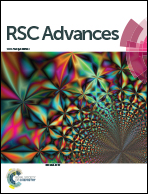Manipulation and assembly behavior of Spirulina-templated microcoils in the electric field†
Abstract
This paper investigates the behavior of metallic Spirulina-templated microcoil in different alternating electric fields and the feasibility to align multiple microcoils into long conductive microcoil-lines. We used plate-to-plate, plate-to-tip, and tip-to-tip electrodes to produce three different kinds of electric field with a working spacing of 1 mm. The behavior of the microcoils in the AC electric fields was studied based on the force analysis and real-time monitoring. For a single microcoil, it could rotate to orient its major axis parallel with the electric field and then translate towards the nearer electrode if the voltage was suitable. The voltage thresholds for translation in plate-to-plate, plate-to-tip and tip-to-tip electrodes are ∼40.5 V, ∼38.2 V and ∼62 V respectively, which are usually ∼10 V higher than those for rotation. For multiple microcoils, they could be directionally aligned and connected one by one in the AC electric field. The simulation results indicate that the polarization of microcoils and the non-uniform electric field strength induced the rotation and translation, respectively, and the field gradient around microcoils caused by their helical configurations also contributed. The electric breakover and self-adjustment behavior of the aligned microcoils were also discussed, showing that this technique is applicable to the fabrication of smart conductive composites.


 Please wait while we load your content...
Please wait while we load your content...